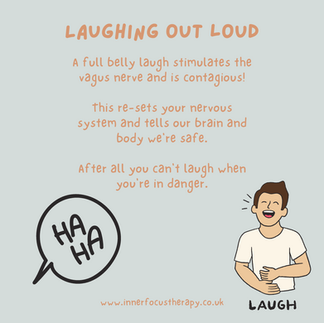BY Kathryn Spence
Accredited BACP Psychotherapeutic Counsellor, Accredited BABCP CBT Therapist, EMDR Therapist
InnerFocus Therapy
1 September 2022
You can read my blog ‘Anxiety Gets a Bad Rap’ which proceeds this blog to help explain how anxiety helps us survive.

What is Anxiety?
Anxiety is our survival emotion; it helps us predict danger and respond incredibly quickly, without rational thought, in order to escape and carry on living. It’s not just a human emotion, but ever living creature on the planet experiences anxiety to survive. That being said, it can be triggered when there is no real danger.
For example, we can become anxious when we're reminded about a trauma from our past, when we're exposed to a phobia, when we worry or catastrophise. This in turn can severely affect our day to day functioning and emotional wellness.
When we’re in danger, our body goes into a state of survival: Fight, Flight, Freeze |
What is Fight, Flight or Freeze?
Fight | Flight | Freeze |
Sympathetic Nervous System is activated | Sympathetic Nervous System is activated | Parasympathetic Nervous System Dorsal pathway is activated |
Hyper-aroused (sped up) Heart beats fast Hot Sweaty Breathing becomes more rapid Tension Hypersensitive to noise, light, touch, smell We get bigger and more dominant Blood thickens, which increases clotting factors to prepare our body for injury | Hyper-aroused (sped up) Heart beats faster Hot Sweaty Breathing becomes more rapid Dry mouth Hypersensitive to noise, light, touch, smell Feel nauseous, knot in stomach | Hypo-aroused (slowed down) Heart rate slows Breathing often slows Cold Numb, stiff & heavy We release endorphins to reduce pain |
This prepares us to be aggressive to our attacker in order to survive. | This same state of hyper-arousal also prepares us to flee. | This prepares us to survive though dissociating or staying still. |
None of these are consciously chosen behaviours, it is an automatic response to survive, and the most likely to work is the one we instinctively do. This can then become a learned habitual response.
For more information on why these symptoms happen read ‘Anxiety Gets a Bad Rap’
All of these body changes are normal and designed to help us when we’re in danger, but they can become unhelpful when they’re triggered when we’re actually safe. The sensations will pass on their own, but we can also learn to calm our body and feel safe again.
Whether our Sympathetic Nervous System or Dorsal Vagus Nerve are activated, we can ‘turn on’ our Vagal Nerve - our 'rest and digest' state. This sounds really complicated, but it’s based on the science of our bodies and below I can make it simple again.

What is the Vagus Nerve?
When the Vagus Nerve of the Parasympathetic Nervous System is activated we are in our 'rest and digest' state, which is designed to counter our fight, flight or freeze response. When it is activated you restore a state of calm, where you can use energy to digest food, be socially connected, compassionate and think clearer. It has benefits for our immune and inflammation system, as well as promotes emotional and physical wellness.
Ways to stimulate your Vagus Nerve
Our vagus nerve reaches from our brain, through to our ears, throat, lungs, heart, stomach, intestines to our colon (as well as some other organs on the way). So there are a variety of different ways to stimulate our vagus nerve to turn on our rest and digest response. You can try some and find which work best for you when you’re triggered.
Although the breathing technique is considered a natural way to breathe, if you have a lung condition like chronic obstructive pulmonary disease (COPD) or asthma, speak with your healthcare provider before trying any type of breathing exercise. If you feel lightheaded at any time, discontinue the breathing exercise. If you're standing, sit down until you're no longer lightheaded.
Try these out for yourself when you feel triggered and see how they work for you, practice just a couple that suit you. But it takes building new neural pathways takes repeated practice and time before these calming methods themselves become instinctual.
Please follow me for more information on FB and Twitter:
Facebook: @innerfocustherapynewcastle
Twitter: innerfocusther1
I am an accredited therapist and offer in-person therapy in Newcastle upon Tyne (UK) as well as online therapy within the UK. Please contact me to enquire about therapy:
References:
Poly Vagal Theory introduced in 1994 by Stephen Porges.




















댓글